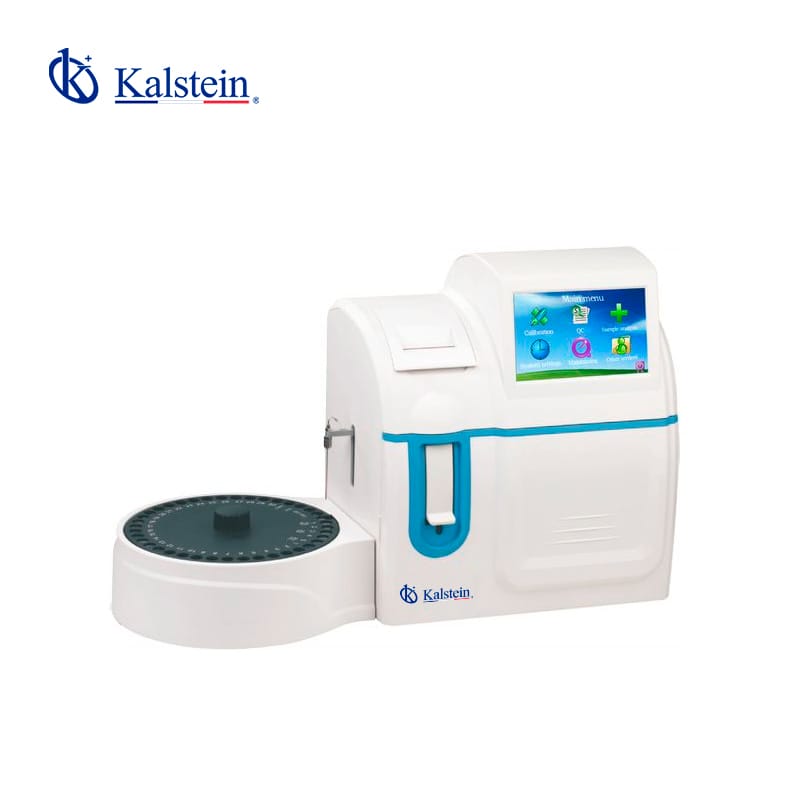Electrolyte analyzers are indispensable tools in modern clinical laboratories. They ensure precise measurements of various electrolytes in blood and serum samples, critical for diagnosing and monitoring many medical conditions. Two prominent products in this market are the Electrolyte Analyzer YR06407//YR06417 from Kalstein and the Electrolyte Analyzer Na/K/Cl/BUN/pH from Medica.
The Kalstein Electrolyte Analyzer YR06407//YR06417 stands out due to its advanced technology and user-friendly design. It offers quick and precise measurements of sodium (Na+), potassium (K+), calcium (Ca2+), lithium (Li+), chloride (Cl−), and pH. Moreover, its auto-calibration feature ensures consistent performance with minimal maintenance. On the other hand, Medica’s Electrolyte Analyzer focuses on providing accurate results for the electrolytes Na+, K+, Cl−, and pH, including Blood Urea Nitrogen (BUN). While both devices cater to essential laboratory needs, subtle differences highlight the strengths of the Kalstein model in terms of versatility and automation.
| Feature | Kalstein YR06407//YR06417 | Medica Na/K/Cl/BUN/pH |
|---|---|---|
| Analytes | Na+, K+, Ca2+, Li+, Cl−, pH | Na+, K+, Cl−, BUN, pH |
| Calibration | Automatic | Manual |
| Maintenance | Low | Medium |
| User Interface | Intelligent, touchscreen | Standard |
| Pricing | Competitive | Moderate |
How They Work
The Kalstein Electrolyte Analyzer YR06407//YR06417 operates with an integrated sensor that efficiently analyzes multiple electrolytes simultaneously, providing quick and reliable results. Its intelligent software simplifies operation and reduces error chances, accommodating routine tasks efficiently. Meanwhile, Medica’s model relies on a traditional take on electrolyte analysis with manual calibration requirements, which might extend setup times, yet it still delivers reliable results for clinical settings.
Purpose
Both analyzers are crucial for evaluating electrolyte balance in patients. These devices serve labs in hospitals and clinical setups by assisting in the diagnosis of conditions like dehydration, kidney diseases, and electrolyte imbalance disorders. While Kalstein’s analyzer extends its utility to more complex cases due to its extended range of analytes, Medica’s unit is an excellent choice for basic electrolyte analysis.
Types
Electrolyte analyzers vary based on the number of analytes they can measure and their operational complexity. The Kalstein model is a multi-analyte system that can handle more complex analyses, whereas the Medica version offers a focused solution on critical electrolytes and BUN.
Market Pricing
Electrolyte analyzers vary in price depending on their features and manufacturer. The Kalstein Electrolyte Analyzer YR06407//YR06417, known for its technological excellence and efficiency, is competitively priced within a range that ensures value for advanced functionality. Medica’s analyzer usually falls into a moderate price bracket, affordable and aligned with its capabilities, yet may require additional costs for consumables over time.
Frequently Asked Questions
What is the primary function of an electrolyte analyzer?
These devices are designed to measure various electrolytes in blood and serum samples, aiding in diagnosing and managing health conditions associated with electrolyte imbalances.
Does the Kalstein YR06407//YR06417 require regular maintenance?
Thanks to its automatic calibration feature, the maintenance need is minimal, allowing for more time-efficient operations.
Can Medica’s model handle complex analyses?
While it’s excellent for basic electrolyte profile testing, complex analyses that require more parameters might be better handled by the Kalstein model.
Advantages and Disadvantages
Kalstein YR06407//YR06417 Advantages: It boasts a broader range of measurable analytes, efficient automatic calibration, and easy-to-use software, which reduces user error and increases productivity. It is ideal for diverse laboratory needs due to its robustness.
Medica Advantages: It provides reliable data for foundational electrolyte analyses, with additional BUN measurement, making it suitable for settings focused on basic testing.
Kalstein Disadvantages: The initial investment might be higher compared to single-purpose analyzers, though it promises long-term efficiency gains.
Medica Disadvantages: Manual calibration and limited test parameters might restrict its application scope in labs that handle diverse tests.
Field Application
In practical scenarios, Kalstein’s analyzer is utilized in high-throughput labs where accuracy and speed are critical. Its automation features allow technicians to focus on other tasks, enhancing lab productivity. Medica’s analyzer serves well in smaller setups where basic testing suffices, such as clinics and smaller hospitals.
Recommendations
For optimal use of the Kalstein model, ensure regular software updates and follow effortless maintenance gained via automated features. For Medica’s analyzer, consistent manual calibration and careful handling can maximize its lifespan. Evaluating specific laboratory needs before purchase will help in choosing the right device.
If you are looking for a fusion of innovation and quality, you’ve come to the right place. At Kalstein, we offer the luxury of exploring our exclusive catalog of laboratory equipment. We manufacture each piece with a level of excellence. Our intuitive and agile online purchasing channels are designed for your convenience, ensuring the most friendly prices. Don’t hesitate any longer, we bring science to life, it’s time to become part of our community. https://kalstein.se/product/electrolyte-analyzer-yr06407-yr06417/.

